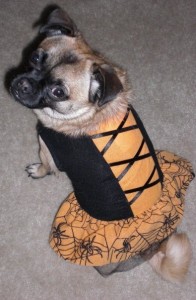
Hallie, Company of Experts' #1 fan, showing off her Halloween costume
Attention all pet owners! Halloween is just around the corner which means strange people wearing costumes, loud noises, lit candles, candy and candy wrappers, in addition to other temptations. While Halloween may be a fun time you and your loved ones, the change in routine, decorations, and smells can often stress out our little furry friends. As avid animal lovers, the Company of Experts’ staff would like to share some tips that can help avoid injury, reduce stress experienced by your pet, and ultimately keep your pets safe.
- Noises: Halloween is full of loud noises. Your doorbell is constantly ringing with trick-or-treaters, who are laughing and screaming with excitement, that can frighten your pet. It is suggested that all family pets are kept inside a quiet room within the house, during trick-or-treating hours, where they are insulated from the Halloween commotion. Equip this room with food, water, toys, and a litter box, if applicable. Check in on your pets throughout the night and let them know that everything is fine and reward them for their good behavior.
- Walk early: If you have a daily routine of walking your pet, make sure to walk your pet before it gets too dark, and before the trick-or-treaters are out in full force. Some kids may already by trick-or-treating, make sure to keep a firm grip on your pet’s leash as many dogs are frightened by people in costumes.
- Strange people in costumes: People of all ages have fun dressing up in costumes, however to your dog or cat, they may not look like people at all. Consequently, your dog or cat may react with fear or aggression if approached by a child or adult in a costume (one more reason to leave your pet home and indoors on Halloween night). Even the friendliest dog can snap at strangers if scared or provoked. Protect everybody’s safety by leaving pets at home. However, if you do decide to take your dog out on Halloween, keep your dog on a shorter-then-normal leash with a firm grip.
- Pet Costumes: If you do decide to dress up your pet, make sure its costume is not constricting, annoying, or unsafe. Your pet’s costume should not impede your pet’s ability to move, see, hear, breath, bark or meow. Examine your pet’s costume carefully to make sure it does not have small, dangling, or easily chewed off pieces that your pet can choke on. Have your pet try on their costume before the big night. If your pet seems distressed, irritated or demonstrates allergic behavior, remove the costume immediately. Do not force your pet to wear a costume if it demonstrates discomfort. Undue stress and discomfort can cause aggression in even the nicest pet.
- Trick-NO-Treats: No matter how much your pet begs for a piece of candy, the bowl full of candy is only for trick-or-treaters. Explain to everyone in your home (including children) how dangerous candy, especially chocolate, are to pets. For younger children, take their Halloween candy supply put it somewhere out of reach of pets. According to the ASPCA:
- Chocolate in all forms—especially dark or baking chocolate—can be very dangerous for dogs and cats. Symptoms of significant chocolate ingestion may include vomiting, diarrhea, hyperactivity, increased thirst, urination and heart rate—and even seizures.
- Candies containing the artificial sweetener xylitol can be poisonous to dogs. Even small amounts of xylitol sweetener can cause a sudden drop in blood sugar, which leads to depression, lack of coordination and seizures. In cases of significantly low blood sugar, liver failure has been known to occur.
- Pick up the evidence: After enjoying some Halloween candy, it is important that you dispose of candy wrappers before your pets get to them. Make sure your pet can’t get into the trash. Swallowing tin foil or cellophane candy wrappers can be as harmful as the candy – potentially causing your pet to choke or experience intestinal blockage.
- Pumpkins: It is fun to adorn the house and yard with festive decorations such as pumpkins and corn. These popular holiday plants are considered to be relatively nontoxic to your pets; however, caution should still be exerted. Pumpkins and corn can produce gastrointestinal upset should your pets ingest them. Intestinal blockage can also occur if large pieces/portions are swallowed.
- Candles: While a jack-o-lantern is festive, it is important that you exercise extreme caution when choosing to add a candle. Animals are curious by nature and often investigate items that intrigue them. Lit candles left burning in pumpkins or decorative holders can be easily knocked over; burning your pet’s paw, wing, or tail on the flame. Animals should be watched around candles during Halloween and anytime of the year.
- Mischief Brews: It is suggested that you do not leave pets outside on Halloween night. Many animal welfare groups warn that pranksters will tease or abduct pets, some may even try to hurt your animals. Animal abuse happens everyday but kids are out playing tricks in full force on Halloween night, so be aware. Again, it is suggested to keep all animals indoors on Halloween night, if possible, to eliminate any chance of this.
- Update ID Tags: It is better to be safe than sorry. Whether you are letting your pet go out on Halloween or not, make sure they are wearing an up-to-date I.D. tag. If for any reason your pet escapes or becomes lost, a collar, tag and/or a microchip can increase the chances that your pet will be returned to you.


